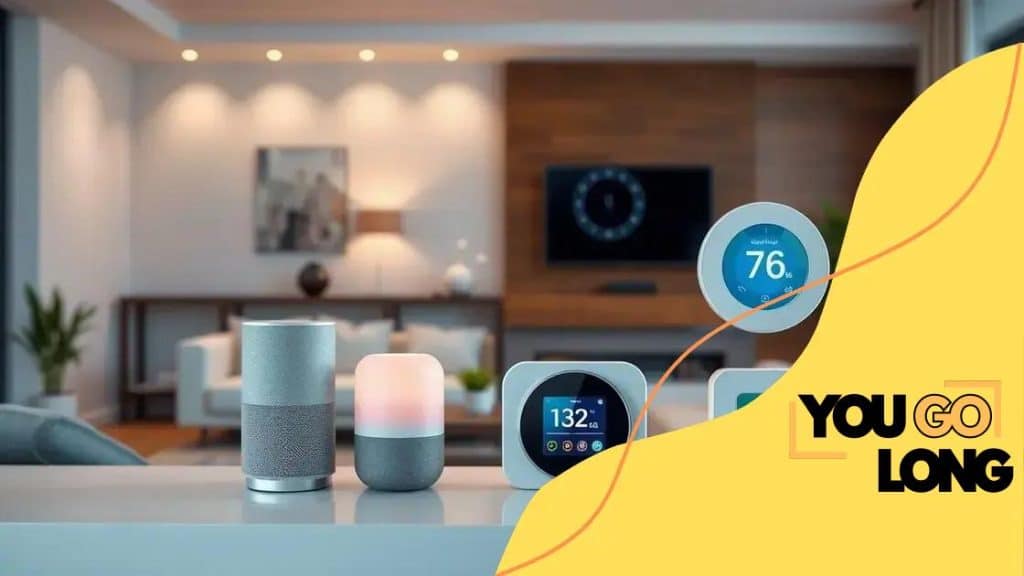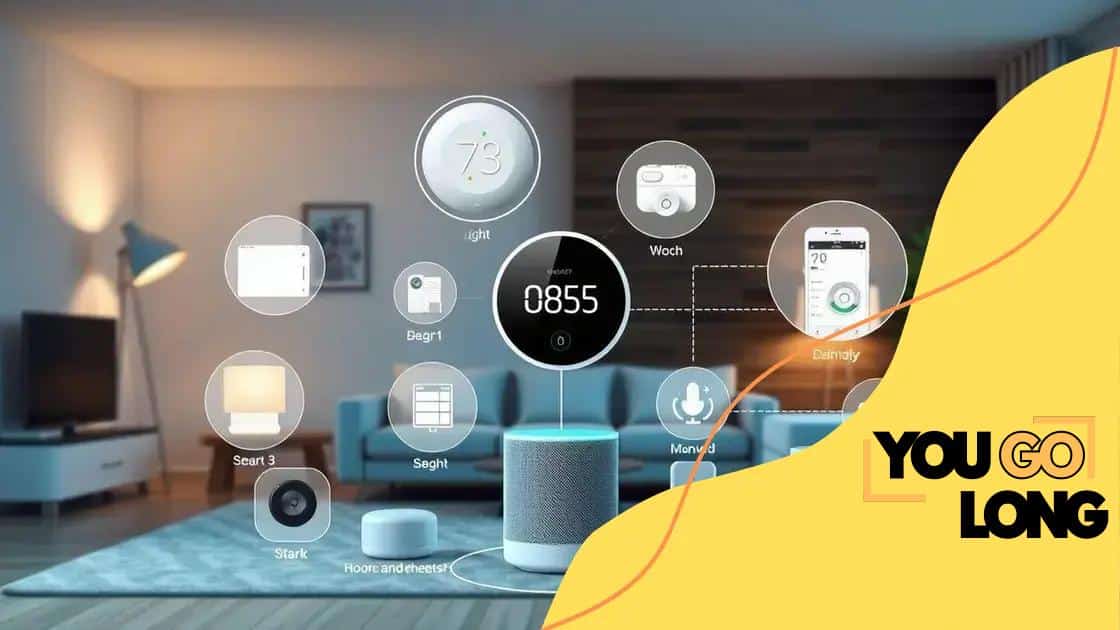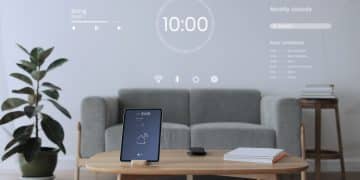How to turn your home into a smart, connected space

Advertisement
Transforming your home into a smart, connected space enhances daily convenience, security, and energy efficiency through the integration of various smart devices and innovative technologies.
How to turn your home into a smart, connected space might seem daunting, but it’s quite achievable. Imagine effortlessly controlling your lights, thermostat, and even your coffee maker from your phone. Intrigued? Let’s dive into how you can make your living space smarter and more efficient.
Understanding smart home technology
Smart home technology is revolutionizing how we live. It allows us to control various aspects of our homes at the touch of a button. From lighting to security, the possibilities are endless.
What is Smart Home Technology?
At its core, smart home technology refers to devices and systems that connect to the internet. This connectivity enables homeowners to manage their appliances remotely. You can adjust your thermostat, lock your doors, or even start your coffee maker, all from your smartphone.
Advertisement
Key Components of Smart Home Technology
Understanding the main components is essential for creating your smart home. Some key devices include:
- Smart speakers
- Smart lights
- Smart thermostats
- Smart security cameras
Each of these components connects to your Wi-Fi, allowing for easy integration. For example, smart speakers like Amazon Echo or Google Nest can act as centralized hubs, controlling other devices with voice commands.
As technology evolves, many people wonder what makes a home truly smart. The answer lies in automation. With smart home systems, you can automate tasks like turning off lights when you leave a room or adjusting your thermostat at specific times of the day. This not only saves energy but also enhances convenience.
Advertisement
Benefits of Smart Home Technology
There are numerous benefits to adopting smart home technology. Here are some advantages:
- Increased energy efficiency
- Enhanced security features
- Improved home management
- Convenience and comfort
By utilizing these devices, homeowners can significantly reduce energy costs and enhance their home living experience. Imagine coming home to a well-lit space, with the perfect temperature waiting for you.
In summary, understanding smart home technology is essential for anyone looking to enhance their living space. With countless devices available, you can create a fully connected home that offers convenience, efficiency, and peace of mind.
Essential devices for a connected home
Creating a connected home requires specific devices that enhance functionality and ease of use. Essential devices make your home smarter, allowing for seamless control over various aspects of your living space.
Smart Speakers
Smart speakers, such as Amazon Echo and Google Nest, serve as the central hub for your connected home. These devices not only play music but also allow you to control other smart devices using voice commands. Imagine adjusting your lights or thermostat just by speaking.
Smart Thermostats
A smart thermostat like the Nest Learning Thermostat helps you manage your home’s heating and cooling efficiently. It learns your preferences and adjusts the temperature automatically, leading to significant energy savings.
Smart Lights
Lighting is another key component in a connected home. Smart bulbs enable you to control the brightness and color of your lights from anywhere. You can set schedules for when lights turn on or off, enhancing security when you’re away.
- Philips Hue bulbs offer a wide range of color options.
- Smart switches allow control without replacing existing bulbs.
- You can create routines where lights mimic your daily patterns.
- Integration with other devices can enhance security features.
Adding smart lights will not only increase convenience but also add a modern touch to your home. Smart security cameras are crucial for monitoring and securing your property.
Smart Security Systems
These systems provide peace of mind, allowing you to keep an eye on your home from anywhere. Smart locks, like August and Yale, allow you to lock and unlock your doors remotely. This is perfect for when you are away or need to grant access to someone without being present.
The combination of all these essential devices creates an integrated system that enhances your lifestyle. Start by assessing your needs and explore which devices fit best in your home environment. The right combination can turn an ordinary home into a remarkable smart sanctuary.
Creating a seamless smart ecosystem

Creating a seamless smart ecosystem is essential for maximizing the benefits of smart home technology. This involves integrating various smart devices to work together smoothly. By doing so, you enhance convenience and functionality throughout your home.
Integrating Devices
The first step in building a smart ecosystem is selecting compatible devices. When devices communicate with each other, they can automate many tasks. For example, your smart thermostat can communicate with your smart blinds to adjust the temperature based on sunlight.
Using a Central Hub
A central hub, like Amazon Echo or Google Nest Hub, can simplify control over multiple devices. This hub acts as the brain of your smart home, allowing you to manage everything with your voice or a single app. It connects to your lights, thermostat, camera systems, and more.
- Voice control helps manage tasks hands-free.
- Automation can save time and increase efficiency.
- Single app management provides easy access.
- Integration enhances security and comfort.
Automation is another crucial element of a seamless ecosystem. By scheduling tasks or setting up triggers, your devices can respond automatically to specific events. For instance, your lights can turn on when you arrive home, providing a warm welcome.
Enhancing User Experience
Personalization improves user experience. Many smart devices learn your habits and routine over time. For instance, a smart thermostat can adjust temperatures based on when you typically wake up or go to sleep. By understanding your preferences, these devices can create an environment tailored just for you.
Creating a seamless smart ecosystem not only simplifies your life but also conserves energy. When devices work together, they improve overall efficiency in the home. You can enjoy a smarter home that enhances comfort, security, and convenience.
Security considerations in smart homes
Security considerations are vital when setting up a smart home. While smart devices offer convenience, they also introduce potential vulnerabilities that you should be aware of to protect your home and family.
Understanding Risks
Each connected device can be a gateway for cyber threats. Hackers can exploit weaknesses in smart home systems to gain access to your personal information or control your devices. Therefore, it’s essential to understand the risks involved when using these technologies.
Important Security Tips
Here are some key security practices to help you safeguard your smart home:
- Always change default passwords to unique, strong passwords.
- Regularly update your device firmware to patch vulnerabilities.
- Utilize two-factor authentication whenever possible.
- Limit the number of devices connected to your network to reduce entry points.
Additionally, consider using a guest network for your smart devices. This keeps your personal devices, like computers and smartphones, separate from your smart home gadgets. This step adds an extra layer of security against potential breaches.
Monitoring and Alerts
Setting up regular monitoring of your smart home is another effective way to enhance security. Many smart security systems allow you to receive alerts for unusual activity, such as attempts to access your cameras or locks. You can even use video doorbells to confirm who is at your door before opening it.
Integrating smart locks and cameras helps maintain security. You can monitor your home from anywhere in the world. Schedules can also be set for your lights to mimic your presence at home, providing an additional barrier against intruders.
Being proactive about your smart home security can lead to a safer living environment. By following best practices and regularly reviewing your security setup, you can enjoy the benefits of smart technology while minimizing risks.
Future trends in smart home innovation
Future trends in smart home innovation are shaping how we will live and interact with our homes. As technology advances, we can expect even more seamless integration of devices that make our lives easier and more enjoyable.
Increased AI Integration
Artificial intelligence (AI) is becoming a cornerstone of smart home technology. With advanced AI, systems can learn from user behavior and adapt automatically. This means that your home will understand your habits and preferences, adjusting settings to match them.
Enhanced Voice Control
Voice control is set to become even more powerful. As natural language processing improves, smart home devices will better understand commands and respond more accurately. This will allow for greater control over multiple devices at once simply by speaking.
- Voice assistants will become more context-aware.
- Multi-language support will expand, serving diverse users.
- Integration with more devices will be seamless.
- Gesture recognition may be incorporated into existing systems.
Another exciting trend is the growth of energy-efficient smart systems. Smart homes will use data to optimize energy consumption. Devices will communicate and work together to minimize waste, resulting in lower utility bills and a greener lifestyle.
Health Monitoring Features
Health and wellness integration is also on the rise. Future smart homes may include features that monitor air quality, detect carbon monoxide, and even track health metrics like heart rate or sleep quality. This focus on health will help users create safer and healthier living environments.
Moreover, we will see a rise in compatibility across devices. Manufacturers are increasingly focusing on interoperability, ensuring various products from different brands can work together effectively. This connectivity will simplify the user experience and enhance the overall efficiency of a smart home.
As we look to the future, it’s clear that smart home innovation will prioritize user experience, energy efficiency, and health and safety. These advancements will make our homes not just smarter, but also more responsive to our daily lives.
FAQ – Frequently Asked Questions about Smart Homes
What are the primary benefits of a smart home?
Smart homes enhance comfort, security, and energy efficiency, making everyday tasks easier to manage.
How do I ensure the security of my smart home devices?
Change default passwords, enable two-factor authentication, and regularly update your devices to protect against cyber threats.
Can I integrate devices from different brands?
Yes, many smart home devices are designed to be compatible with one another, allowing for a seamless connected experience.
What future trends should I expect in smart home technology?
Future trends include increased AI integration, advanced voice control, and improved health monitoring features for enhanced living environments.





